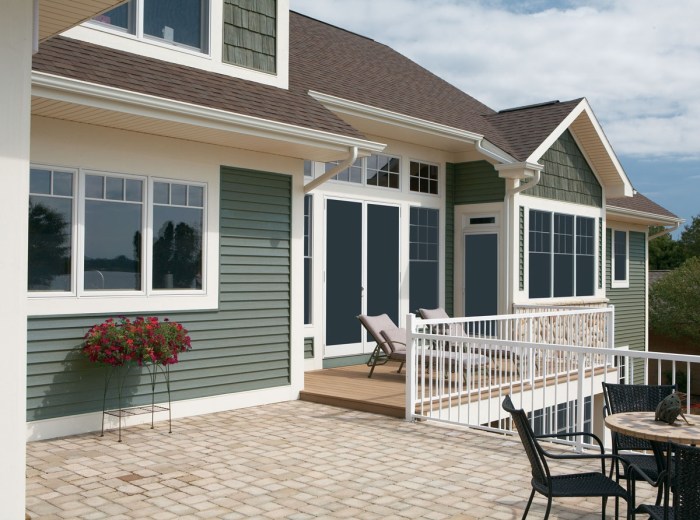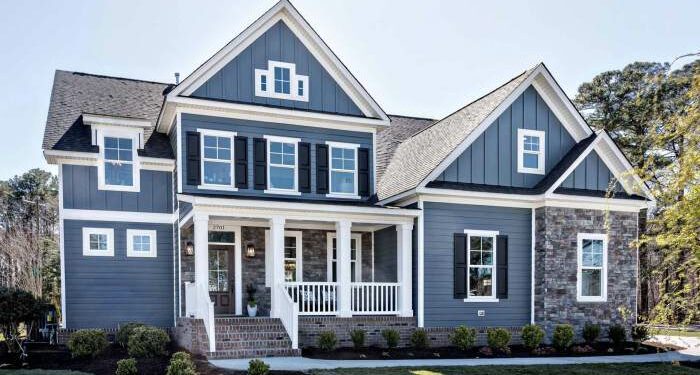Embark on a journey to transform your home with the perfect combination of windows and siding. This guide will delve into the benefits, types, installation processes, and cost considerations, offering valuable insights to enhance your living space.
Benefits of Windows and Siding
Installing new windows and siding can bring a multitude of benefits to homeowners. Not only can they enhance the overall appearance of a house, but they can also improve energy efficiency and ultimately save money on utility bills.
Energy Efficiency with New Windows
Energy-efficient windows are designed to reduce heat transfer, keeping your home cooler in the summer and warmer in the winter. This can lead to significant savings on heating and cooling costs throughout the year.
Improved Curb Appeal with Updated Siding
Upgrading the siding on your home can instantly boost its curb appeal. Whether you choose a modern color or a durable material like vinyl, new siding can give your house a fresh and inviting look that will make it stand out in the neighborhood.
Types of Windows
When it comes to residential properties, there are several types of windows to choose from based on functionality and aesthetic preferences. Let's explore some of the common options available.
Single-Hung vs. Double-Hung Windows
Single-hung windows are a popular choice where only the bottom sash moves vertically, while the top sash remains fixed. On the other hand, double-hung windows offer more versatility as both the top and bottom sashes can be opened for improved ventilation.
This feature also makes double-hung windows easier to clean from the inside.
Casement Windows
Casement windows are hinged on one side and open outward with a crank mechanism. These windows provide excellent ventilation as they can be fully opened to allow fresh air into the room. Additionally, casement windows offer a classic and timeless look that enhances the overall aesthetics of a home.
Types of Siding Materials
When it comes to siding materials, there are several options available, each with its own set of characteristics and benefits. Understanding the different types of siding materials can help homeowners make an informed decision based on their specific needs and preferences.
Vinyl Siding
Vinyl siding is a popular choice due to its affordability and low maintenance requirements. It is available in a wide range of colors and styles, making it versatile for different home designs. While vinyl siding is durable and resistant to rot and insect damage, it may not be as impact-resistant as other materials.
Wood Siding
Wood siding offers a natural and traditional look that can enhance the aesthetic appeal of a home. However, wood siding requires regular maintenance, including painting or staining to protect it from moisture and rot. While wood siding is durable, it may be prone to warping or splitting over time.
Fiber Cement Siding
Fiber cement siding is a durable and low-maintenance option that mimics the look of wood without the susceptibility to rot or pests. It is resistant to fire, moisture, and insects, making it a long-lasting choice for homeowners. Fiber cement siding is available in various textures and finishes to suit different architectural styles.
Metal Siding
Metal siding, such as aluminum or steel, is known for its durability and resistance to extreme weather conditions. It is a low-maintenance option that can last for decades with minimal upkeep. Metal siding is available in different profiles and colors, offering a modern and sleek appearance to homes.Each of these siding materials has its own unique characteristics and maintenance requirements, so homeowners should consider factors such as cost, durability, and aesthetics when choosing the right siding for their home.
Window Installation Process

When it comes to installing or replacing windows, there are several important steps to ensure a successful and efficient process. Proper measurements, sealing, and attention to detail are crucial for the longevity and effectiveness of your new windows. Here, we will discuss the key aspects of the window installation process and provide tips for maximizing energy efficiency.
Importance of Proper Measurements
- Accurate measurements are essential to ensure that the new windows fit properly and function as intended.
- Measure the width, height, and depth of the window opening to determine the correct size for the replacement window.
- Improper measurements can lead to gaps, drafts, and poor insulation, impacting the energy efficiency of your home.
Sealing During Window Installation
- Proper sealing is critical to prevent air and moisture infiltration, which can cause drafts, water damage, and energy loss.
- Use high-quality sealants and insulation materials to create a tight seal around the window frame.
- Ensure that all gaps and seams are properly sealed to maximize the energy efficiency of your new windows.
Tips for Ensuring Energy Efficiency
- Choose energy-efficient windows with features such as low-E coatings, multiple panes, and gas fills to reduce heat transfer.
- Consider installing weather-stripping and caulking around the window frame to minimize air leakage.
- Opt for professional installation to ensure that the windows are properly sealed and insulated for maximum energy efficiency.
Siding Installation Process
Installing siding on a home is a crucial step in protecting the exterior of the house from the elements. The process involves several key steps to ensure proper installation and longevity of the siding.Insulation and moisture barriers play a vital role in siding installation.
Insulation helps regulate the temperature inside the home, keeping it warm in the winter and cool in the summer. Moisture barriers are essential to prevent water and moisture from seeping into the walls, which can cause damage over time.
Maintaining and Cleaning Siding Materials
- Vinyl Siding: Clean with a mixture of water and mild detergent, using a soft brush or cloth. Avoid using harsh chemicals that can damage the siding.
- Fiber Cement Siding: Wash with a garden hose or pressure washer, using a mild detergent if needed. Inspect for any cracks or damage that may need repair.
- Wood Siding: Scrub with a brush and mild detergent, then rinse with water. Apply a fresh coat of paint or stain every few years to protect the wood.
- Aluminum Siding: Clean with a solution of water and vinegar, using a soft brush or cloth. Inspect for any dents or scratches that may need repair.
Cost Considerations

When it comes to windows and siding installation, cost is a significant factor that can influence the overall outcome of your project. Understanding the various factors that impact the cost, as well as how to budget effectively and get quotes from contractors, is crucial for a successful renovation or upgrade.
Factors Influencing Cost
- The size and type of windows and siding materials chosen can greatly affect the overall cost of the project. Larger windows or premium siding materials will typically come with a higher price tag.
- The quality of materials used is another key factor in determining cost. Opting for high-quality, durable materials may come with a higher upfront cost but can save money in the long run by reducing maintenance and replacement expenses.
- Labor costs can vary depending on the complexity of the installation process, as well as the experience and expertise of the contractors hired. It's essential to consider labor costs when budgeting for your project.
Budgeting Tips and Getting Quotes
- Research and compare prices for different types of windows and siding materials to find the best value for your budget.
- Set a realistic budget and be prepared to prioritize certain features or materials based on your needs and preferences.
- Get multiple quotes from reputable contractors to ensure you are getting a fair price for the work being done. Be wary of significantly lower quotes, as they may indicate subpar materials or workmanship.
- Ask for a detailed breakdown of costs in each quote to understand where your money is going and avoid any surprise expenses during the project.
Closing Notes
In conclusion, upgrading your windows and siding not only enhances the aesthetics of your home but also improves energy efficiency and overall value. With the right choices and considerations, you can create a space that reflects your style and functionality.
Commonly Asked Questions
What are the benefits of energy-efficient windows?
Energy-efficient windows can help reduce utility bills by maintaining consistent indoor temperatures, reducing the need for heating or cooling.
What are the differences between single-hung and double-hung windows?
Single-hung windows have a fixed top sash and a movable bottom sash, while double-hung windows allow both sashes to move independently.
How do you maintain vinyl siding?
Regularly clean vinyl siding with a mixture of soap and water, and inspect for any damage or mold growth to address promptly.












